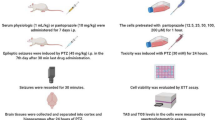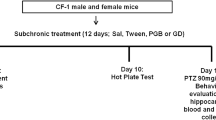Abstract
2,3 dimercaptopropanol (BAL), is a dithiol chelating agent, used for the treatment of heavy metal intoxication; however, this compound has low therapeutic efficacy and in some situations may cause neurotoxic effects. In experimental models, administration of high doses of BAL produces seizures that culminate in animal death. However, investigations on the modulation of neurotransmitter system(s) involved in BAL-induced seizures are still lacking in the literature. In the present study, the neurotoxicity of BAL, as measured by the manifestation of seizures was examined and the modulation of glutamatergic and GABAergic receptors and ion channels potentially involved in BAL-induced seizures was investigated. The results demonstrated that BAL (18.6 mg/kg) induced seizures and all mice died within one day. GABAergic allosteric modulators (3 or 12 mg/kg diazepam and 50 mg/kg phenobarbital) blocked the appearance of seizure and reduced almost completely the death caused by BAL. Carbamazepine (5 mg/kg) significantly reduced the incidence of BAL-induced seizures, while sodium valproate and MK-801 were not effective in reducing the incidence of seizures. Valproate (300 mg/kg) and MK-801(0.5 mg/kg) prolonged the latencies for onset of seizures; however, all animals died within one day after BAL administration. High doses of ZnCl2 (135 mg/kg) blocked the appearance of seizures episodes, but no animal survived more than one day. The content of total non-protein—SH in brain of mice treated with 18.6 and 124 mg/kg BAL increased from 0.9 ± 0.3 nmol/g (control animals) to 1.7 ± 0.3 and 3.5 ± 0.8 nmol/g, respectively. In vitro, 0.1–1 mM concentrations of BAL inhibited [3H]glutamate and [3H]MK-801 binding, but increased the binding of [3H]muscimol to brain synaptic plasma membrane. The results reported here demonstrate that GABAergic allosteric modulators (diazepam and phenobarbital) and carbamazepine, a compound that acts by prolonging the recovery of voltage-activated ion channels from inactivation, are able to abolish BAL-induced seizures, while the NMDA antagonist (MK-801) prolonged the latencies for onset of seizures suggesting that modulators of this subtype of glutamate receptor have a modest role on BAL-induced seizures. The results of the present study suggest that allosteric modulators of GABAergic system and carbamazepine, a voltage-gated Na+-channel antagonist, should be considered for the treatment of animals or patients intoxicated with BAL.
Similar content being viewed by others
REFERENCES
Pepin, J., Milord, F., Khonde Na, Niyonsenga, T., Loko, L., Mpia, B., and Dewals, P. 1995. Risk-factors for encephalopathy and mortality during melarsoprol treatment of Trypanosoma-Brucel-Gambiense sleeping sickness. Trans. of the Roy. Soc. of Trop. Med. and Hyg. 89:92–97.
Jennings, F. W., Atouguia, J. M., and Murray, M. 1996. Topical chemotherapy for experimental murine African CNS-trypanosomiasis: The successful use of the arsenical, melarsoprol, combined with the 5-nitroimidazoles, fexinidazole or MK-436. Trop. Med. & Internat. Health. 1:590–598.
Jennings, F. W., Chauvioro, G., Viodo, C., and Murray, M. 1996. Topical chemotherapy for experimental African trypanosomiasis with cerebral involvement: The use of melarsoprol combined with the 5-nitroimidazole, megazol. Trop. Med. & Internat. Health 1:363–366.
Graziano, J. H.; Lolacono, N. J.; Moulton, T.; Mitchell, M. E.; Slavkovich, V. and Zarate, C. 1989. Controlled study of meso-2,3-dimercaptosuccinic acid for the management of childhood lead intoxication. Pediat. Pharmacol. and Therapeutics 133-39.
Aposhian, H. V.; Maiorino, R. M.; Mario Rivera; Bruce, D. C.; Dart, R. C.; Hurlbut, K. M.; Levine, D. J.; Zheng, W.; Quintus Fernando, Carter, D.; and Aposhian, M. M. 1992. Human studies with the chelating agents, DMPS and DMSA. Clin. Toxicol. 30:505–28.
Clinical Pharmacology 2000 on line. http://www.imc.gsm.com/.
Clarkson, T. W. 1972. The pharmacology of mercury compounds. Annu. Rev. Pharmacol. Toxicol. 12:375–406.
Clarkson, T. W. 1990. Mercury-An element of mystery. N. Engl. J. Med. 323:1137–39.
Toet, A. E., Dijk, van. A., Savelkoul, T. J. F., and Meulenbelt, J. 1994. Mercury kinetics in a case of severe mercuric chloride poisoning treated with dimercapto-1-propane sulphonate (DMPS). Hum. & Exper. Toxicol. 13:11–16.
Aposhian, M. M., Maiorino, M. R., Xu, Z., and Aposhian, V. 1996. Sodium 2,3-dimercapto-1-propanesulfonate (DMPS) treatment does not redistribute lead or mercury to the brain of rats. Toxicology 109:49–55.
Aaseth, J., Jacobsen, D., Andersen, O., and Wickstrom, E. 1995. Treatment of mercury and lead poisonings with dimercaptosuccinic acid and sodium dimercaptopropanesulfonate. Analyst 120:853–854.
Emanuelli, T., Rocha, J. B. T., Pereira, M. E., Souza, D. O. G., and Beber, F. A. 1998. Aminolevulinate dehydratase inhibition by 2,3-dimercaptopropanol is mediated by chelation of zinc from a site involved in maintaining cysteinyl residues in a reduced state. Pharmacol. & Toxicol. 83:95–103.
Hoover, T. D. and Aposhian, H. V. 1983. BAL increases the arsenic-74 content of rabbit brain. Toxicol. Appl. Pharmacol. 70:160–162.
Aposhian, H. V. 1983. DMSA and DMPS-water soluble antidotes for heavy metals poisoning. Ann. Rev. Pharmacol. Toxicol. 23:193–215.
Madonia, P. and Palazzoadriano, M. 1964. Eccitazione centrale da molecole a struttura tiolica. Bollettino della societa italiana di biologia sperimentale 6:295–297.
Aizenman, A. E., Lipton, S. A., and Loring, R. H. 1989. Selective modulation of NMDA responses by reduction and oxidation. Neuron 2:1257–1263.
Reynolds, I. J., Aizenman, A. E., and Hartnett, K. A. 1990. Oxigen free-radicals regulate NMDA receptor function via a redox modulatory site. Neuron 5:841–846.
Sullivan, J. M., Traynelis S. F., Chen H. S., Escobar, W., Heinemann, S. F., and Lipton, S. A. 1994. Identification of two cysteine residues that are required for redox modulation of the NMDA subtype of glutamate receptor. Neuron 13:929–36.
Ogita, K., Enomoto, R., Nakahara, F., Ishitsubo, N. and Yoneda, Y. 1995. A possible role of glutathione as an endogenous agonist at the N-methyl-d-Aspartate recognition domain in rat brain J. Neurochem. 64:1088–1096.
Westbrook, G. L. and Mayer, M. L. 1987. Micromolar concentrations of Zn2+antagonize NMDA GABA responses of hippocampal-neurons. Nature 328:640–643.
Peters, S., Koh, J., and Choi, W. D. 1987. Zinc selectively blocks the action of N-Methyl-D-Aspartate on cortical-neurons. Science 236:589–593.
Christine, C. W. and Choi, W. D. 1990. Effect of zinc on NMDA receptor-mediated channel currents in cortical-neurons. J. Neurosci. 10:108–116.
Jones, D. H. and Matus, A. I. 1974. Isolation of synaptic plasma membrane from brain by combined flotation-sedimentation density gradient centrifugation. Biochim. Biophys. Acta 356: 276–287.
Demasi, M., Penatti, C. A. A., De Lucia, R. and Bechara, E. J. H. 1996. The prooxidant effect of 5-aminolevulinic acid in the brain tissue of rats: implications in neuropsychiatric manifestations in porphyrias. Free Rad. Med. Biol. 20:291–299.
Lowry, O. H, Rosebrough, N. J., Farr, A. L., and Randall, R. J. 1951. Protein measurement with the Folin phenol reagent. J. Biol. Chem. 193:265–275.
Johnston, G. A. S. GABAA. receptor pharmacology. 1996. Pharmacol. Ther. 69:173–98.
Foster, A. C. and Wrong, E. H. F. 1987. The novel anticonvulsant MK-801 binds to the activated state of the N-methyl-D-aspartate receptor in rat brain. Br. J. Pharmacol. 91,403–409.
White, H. S. 1999. Comparative anticonvulsant and mechanistic profile of the estabilished and newer antiepileptic drugs. Epilepsia 40(Suppl. 5):S2–S10.
Loscher, W. 1993. Effects of the antiepileptic drug valproate on metabolism and function of inhibitory and excitatory aminoacids in the brain. Neurochem. Res. 18:485–502.
Albuquerque, E. X., Pereira, E. F. R., Braga, M. F. M., and Alkondon, M. 1998. Contribution of nicotinic receptors to the function of synapses in the central nervous system: The action of choline as a selective agonist of alpha 7 receptors. J. Physiol. 92:309–16.
Sorkin, E. M. and Hell, R. C. 1985. Terfenadine: a review of its pharmacodynamic properties and therapeutic efficacy. Drugs 29:34–56.
Czuczwar, S. J., Gasior, M., Borowicz, K., Starownik, R., and Kleinrok, Z. 1996. Ca2+channel blockade and the antielectroshock activity of NMDA receptor antagonists, CPG 40116 and CPG 43487, in mice. Euro. J. of Pharmacol. 312:27–33.
Bowery, N. G. 1993. GABA B receptor pharmacology. Annu. Rev. Pharmacol. Toxicol. 33:109–47.
Schimidt, A. P., Lara, D. R., Maraschin, J. F., Perla, A. S., and Souza, D. O. 2000. Guanosine and GMP prevent seizures induced by quinolinic acid in mice. Brain Research 1.
Baron, B. M., Dudley, M. W., McCarty, D. R., Miller, F. P., Reynolds, I. J., and Schimidt, C. J. 1989. Guanine nucleotides are competitive inhibitors of N-methyl-D-aspartate at its receptor site both in vitro and in vivo. J. Pharmacol. Exp. Ther. 250: 162–169.
Paz, M. M., Ramos, M., Ramirez, G., and Souza, D. 1994. Differential effects of guanine nucleotides on kainic acid binding and on adenylate cyclase in chick optic tectum. FEBS Lett. 355:205–208.
Regner, A., Ramirez, G., Belló -Klein, A., and Souza, D. 1998. Effects of guanine nucleotides on glutamate-induced chemiluminescence of hippocampal slices submitted to hypoxia. Neurochem. Res. 23:519–524.
Tasca, C. I., Wofchuk, S. T., Souza, D. O., Ramirez, G., and Rodnight, R. 1995. Guanine nucleotides inhibit the stimulation of GFAP phosphorylation by glutamate. NeuroReport. 6:249–252.
Ellman, G. L, 1959. Tissue sulphydryl groups. Arch. Biochem. Biophys. 82:70–77.
Jacques-Silva, M. C., Broch, L. C., Flores, E. M. M., Nogueira, C. W., and Rocha, J. B. T., 2000. diphenyl diselenide and ascorbic acid changes deposition of selenium and ascorbic acid in liver and brain of mice. (Pharmocology & Toxicology)
Emanuelli, T., Rocha, J. B. T., Pereira, M. E., Porciuncula, L. O., Morsch, V. M. Martins, A. F., and Souza, D. O. 1996. Effect of mercuric chloride intoxication and dimercaprol treatment on δ-aminolevulinate dehydratase from brain, liver and kidney of adult mice. Pharmacol. & Toxicol. 79:138–43.
Davies, J. A. 1995. Mechanisms of action of antiepiletic drugs. Seizure 4:267–71.
White, H. S. 1997. Clinical significance of animal seizure models and mechanism of action studies of potential antiepileptic. Drugs 38:S9–S17.
Westbrook, L. G. and Mayer, M. L., 1987. Micromolar concentrations of Zn antagonize NMDA and GABA responses of hippocampal neurons. Nature 328:640–643.
Kutsuwada, T., Kashiwabuchi, N., Mori, H., Sakimura, K., Kushiya, E., Araki, K., Meguro, H., Masaki, H., Kumanishi, T., Arakawa, M., and Mishina, M. 1992. Molecular diversity of the NMDA receptor channel. Nature 358:36–41.
Meguro, H., Mori, H., Araki, K., Kushiya, E., Kutsuwada, T., Yamazaki, M., Kumanishi, T., Arakawa, M., Sakimura, K.,and Mishina, M. 1992. Functional characterization of a heteromeric NMDA receptor channel expressed from cloned c DNAs. Nature 357:70–74.
Rassendren, F. A., Lory, P., Pin, J. P., and Nargeot, J. 1990. Zinc has opposite effects on NMDA and non-NMDA receptors expressed in Xenopus oocytes. Neuron 4:733–740.
Choi, D. W. and Koh, J. Y. 1998. Zinc and brain injury. Ann. Rev. Neurosci. 21:347–75.
Aizenman, E., Reynolds, I. J., and Rush, E. A. 1990. Reduction of NMDA receptors with dithiothreitol increases [3H]-MK-801 binding and NMDA-induced Ca2+ fluxes. Br. J. Pharmacol. 101:178–82.
Pan, Z. H., Bahring, R., Grantyn, R., and Lipton, S. A.1995. Differential modulation by sulphydryl redox agents and glutathione of GABA-evoked and Glycine-evoked currents in rat retinal ganglion-cells. J. Neurosci. 15:1384–91.
Author information
Authors and Affiliations
Rights and permissions
About this article
Cite this article
Nogueira, C.W., Soares, F.A., Bolzan, R.C. et al. Investigations into the Mechanism of 2,3-Dimercaptopropanol Neurotoxicity. Neurochem Res 25, 1553–1558 (2000). https://doi.org/10.1023/A:1026658217907
Issue Date:
DOI: https://doi.org/10.1023/A:1026658217907




